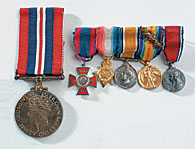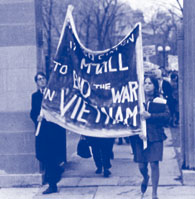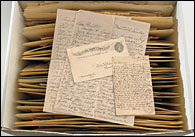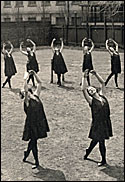Alchemy in the Archives (Page 3)
Alchemy in the Archives (Page 3) McGill University
User Tools (skip):
Alchemy in the Archives (Page 3)
Saving for the future
 McGill and
World War II medals McGill and
World War II medals
|
|
When a May exposition of Archives memorabilia closed with the opportunity for the public to ask questions, one in particular was inevitable: what about digital? The issue on the mind of every archivist is, like the format itself, a binary one, touching on both archiving and access. While staff in the Archives work closely with McGill's information technology sector to develop an archiving strategy for modern documentation created and kept purely on computer, Pelletier is not ready to carpet-digitize the entire existing collection and dispense with the old-fashioned stacks of paper and microfilm holdings.
"Digitizing does not ensure long-term preservation," she warns. "There's no evidence that the current digital technologies will survive in the long term. If we could ensure that every image and text file created was software and hardware independent, thatwhere we'd be headed. But until we can make that financial and organizational commitment, we focus our efforts on digitization for access."
 Campus
protest in the 1970s Campus
protest in the 1970s
|
|
 Letters from the
Annie Holiday Pelletier collection Letters from the
Annie Holiday Pelletier collection
|
Her staff has been busy. The Archives recently revamped its website (www.archives.mcgill.ca) and has populated it with digital renderings of many of the collection's most visual artifacts. Already, 7,000 of the photo archives have been scanned and placed in a searchable database, along with some significant documents and telling ephemera. Pelletier plans to add streaming audio of McGill music, video of theatre productions and campus events, and "theme shows" that string together the most interesting pieces of a collection or era.
"These things are visual and public, but they're also vital documents of the culture of the University," she says. "We exist to acquire and preserve archives, but also to make them available. Digitization makes materials more accessible. That sounds so simple, but it's extraordinary in terms of the exposition it allows us to do when we're freed from having to find three-dimensional space."
Filling the gaps
 The Modern
Dance class of 1923 The Modern
Dance class of 1923
|
What the Archives has, after only 40 years, is impressive. What it does not have may be surprising. There are very few artifacts of student life at McGill. And because the acquisition of such items is on the fringe of its mandate, the department relies on contributions from alumni and their descendants to fill in the considerable gaps. One recent arrival is an exhaustive collection of letters from the family of Annie Holiday Pelletier, one of McGill's first female students. Included are letters she wrote to her parents during her time as an undergraduate, from 1895 to 1899.
"The letters open a significant window on the University at that time, and inform us about family and religious life in plain language," says Johanne Pelletier (no relation). "There are so few sources in which students speak for themselves about life on campus, and this is one of the most revealing and beautifully crafted parts of the Archives."
Piece by piece, the collection of ephemera continues to grow. Ian Pilarczyk decided to extend his regular personal forays onto eBay, the Internet auction site, to include searches for McGill artifacts. Budgeting a few dollars for the purpose, he's thus far purchased a series of classic postcards, some rare intercollegiate football game programs and a 1913 McGill keychain that was owned by a young freshman named Wilson who died the next year fighting in France. Pilarczyk plans to donate it all to the Archives. "This is purely a work of love," he says. "It's a good cause -- McGill's patrimony, an important thing to preserve."
This small involvement as a voluntary search agent for the Archives has turned Pilarczyk into an advocate. "McGill's history is more than just the obvious," he continues. "It's the day-to-day activities of student life, which decades from now people may find very interesting. I wish that 100 or 150 years ago, more people had said, 'You know what, it may be really interesting to people to realize what students were doing in the 1870s.'
"How many people inherit old McGill items from relatives or friends -- old class notes, textbooks, t-shirts, memorabilia -- and just chuck them? How many think to call the Archives first?"
Says Burr: "Every acquisition has at least one thing in common with the rest: someone realizes it has long-term value."
The rest is history.
Ed Kromer is a freelance writer living in Montreal.
Private stashStraying from its central mandate to preserve official University documents, the Archives also maintains several private collections chronicling the life and times of prominent McGill principals and professors, many of whom earned national and international renown. The Dawson papers recall the achievements and thoughts of Sir John William Dawson (Principal, 1855-1893) and his son, George Mercer Dawson (a McGill graduate), two of the most influential earth scientists of their eras, in correspondence, papers, photos, sketches, drawings, journal entries, notes, even a mint-condition leather-bound passport. The papers of Sir Arthur Currie (Principal, 1920-1933) follow Canada's brilliant WWI supreme commander across the nation as he delivers nationalist speeches until his death in 1933. Materials from the Sir Ernest Rutherford collection demonstrate the Nobel Prize-winning chemist's seminal atomic research in the early 1900s. Dr. William Osler's papers shed light on the man who invented the modern bedside manner, a revolution in health care in the late 19th century. The most historic private holding may be the first draft of the United Nations International Declaration of Human Rights, from the papers of its author, John Humphrey, a McGill law professor who served on the UN Secretariat from 1946 to 1966. The yellowing edges, period type font and neatly handwritten notations in the margin give a sense of intimacy to the foundation of one of the most influential documents in human history. As for the man who started it all with his bequest of a 46-acre estate and 10,000 pounds, the Archives has precious little on founder James McGill. Outside of his will and some photographic reproductions of painted portraits and estate landscapes, only a journal and a few four-pocket diaries remain in the care of the Archives. "People assume we have everything on James McGill," says senior archivist Gordon Burr. "Unfortunately, that's not the case." |


